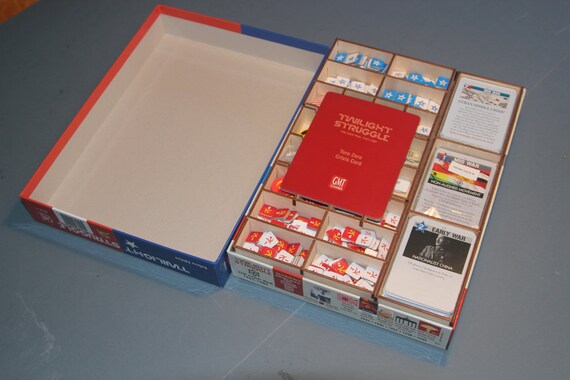Great deals on Twilight Struggle. Expand your options of fun home activities with the largest online selection at eBay.com. Fast & Free shipping on many items! Twilight Struggle is a strategy game set in the Cold War that presents new and different challenges with every game session. The game map is a world map of the period, whereon players move units and exert influence in attempts to gain allies and control for their superpower. Twilight Struggle is a 2 player historical board game that follows decades of warfare between the United States and the Soviet Union. Based on a timeline of 45 years, each turn advances the players approximately 3-5 years into the future.
OVERVIEW
Twilight Struggle is a 2 player historical board game that follows decades of warfare between the United States and the Soviet Union. Based on a timeline of 45 years, each turn advances the players approximately 3-5 years into the future. Players will move units across the map while gaining allies and control while playing this card-driven board game.
If you don’t own Twilight Struggle already, check it out here on Amazon.
GAMEPLAY
Setup
Begin by placing the board in the middle of both playerswith room for a discard pile next to it. The initial influence chips will thenbe placed on the board as well as the VP tokens at the start of the VictoryPoint track which will be moved in either direction while scoring. Each playerwill then be dealt 8 cards each from the Early War deck. After receiving theirhands, each player will add the specified amount of additional influence piecesto the board indicated on their cards if necessary. The USSR player will takethis step first, followed by the US player.
Goal
The object of the game is to gain control over as manycountries as possible to gain more Victory Points than the enemy player by theend of the game.
Player Actions
During gameplay, the influence marker will be flipped tothe colored side when a country is controlled. In order to gain control of acountry, the influence must be greater than or equal to the country’s indicatedstability number as well as the opponent’s influence. For example, if a countryhas a stability number of 3 has 1 USSR marker on it, the US player must place 4of their markers on the same country to take control of it. All battlegroundcountries are marked with a purple banner.
Each player’s turn will follow the order that is displayedin the lower left hand corner of the game board:
First, increase the defcon by 1 if possible. Then, eachplayer will be dealt more cards so their hand always equals 8. This rule standsfor turns 1,2,3 and 9 as needed. Rounds 1-3 will be played with the Early Warcards only, Mid War cards will be added for rounds 4-7, and the Late War cardsare added to the deck to be used for the remainder of the game.
The next step is called the Headline Phase. Players will draw1 card and place it face down on the table in front of them, and each will flipit over facing up at same time. The card with the highest number in the upperleft corner is played first. If these numbers are the same, the US player willgo first. The Action Round phase follows and players will each play cards fromtheir hands 1 at a time going back and forth. Turns 1-3 will have 6 actionrounds per player, and then there will be 7 action rounds for the rest of thegame.
Players will play the event on their card if the star inthe upper left corner matches their country’s color, which is red for USSR,white for US, or half red and half white for both. For example, the US playercan play the action of a card if the star is white or both red and white. Ifthe card has asterisk at the end of the text, it is only used once and will notremain in the game. All other cards go to the discard pile after resolving andcould be reshuffled into the deck if needed.

Both opponents will play cards to earn operations points,which is the value in the star on the upper left of each card. They can chooseto use these points in 1 of 3 ways per turn. First, if the color of the stardoes not match the active player’s country, they have the option to resolve thecard before or after their operations points are used in the game. If the colorof the star matches the player’s color or shows both, only the operationspoints are used and no action is played. Influence markers in the amount of theoperation points listed on the card should be placed on any country the playerhas influence or that is adjacent to one they have influence in. It takes 2points per influence marker to add them to a country that is controlled by theopponent. These markers can also be spread out to multiple countries duringthis turn.
The next option is to perform a realignment roll on anycountry that the opponent has influence in. Each player will roll 1 dice andadd 1 to the result for each controlled adjacent country of the opposingsuperpower, if your country is adjacent to your superpower, and if your countryhas more influence than the opponent. The player with the highest roll willremove the difference between the 2 in their enemy’s influence points. Theamount of rolls should be equal to the operations points, and multiplecountries can be selected during this turn of there are enough operationspoints indicated on the card.
Lastly, players can choose to use their operations points to perform a coup. To do this, you will multiply the country’s stability points that your opponent has influence in by 2, roll 1 dice and add the operations points on the card to the results of the roll. If this number is greater than twice the country’s stability points, your opponent will
Once per turn, you can play a card in order to move forwardon the space race track. The operations value on the card should be greaterthan or equal to the number printed on the next space you would like to advanceto. After rolling the dice, if the value is equal to the required value on theboard, you can move forward 1 space. Some spaces give victory point bonuses tothe first and second player to get to that position as indicated on the board.Scoring cards are played like normal event cards throughout the game.
Points are based on the level of influence players have ineach region as follows:
Presence is having control of 1 country in a region.Control is when you have control of more countries than the opponent and allbattleground countries in that region. Domination is having control of morebattleground and non-battleground countries in a region than the opponent. Youmust have 1 battleground and 1 non-battleground country to dominate a region.The map on the board shows the victory points for each level of presence ineach region. 1 bonus point is awarded for each battleground country that iscontrolled and another for each controlled country that is adjacent to theopposing superpower.
Twilight Struggle Map
After all action rounds are finished, check the MilitaryOperations marker on the bottom of the board. If that number is lower than thecurrent defcon level, the opponent will gain the difference in the two numbersin victory points.
Each superpower will have 1 card in their hand beforemoving on to the next round, and should show each other the bottom of theircard to prove that it is not a scoring card, which must be played in the sameround it is drawn. Whoever has the China card at the end of the game gets 1bonus victory point.
How to End the Game
The game can end in any of these 3 ways: If a playerreaches 20 victory points , if the defcon marker moves to 1 causing the activeplayer to lose the game, or if one player controls Europe during Europeanscoring. Otherwise, the game will end after a total of 10 rounds have beenplayed and will be scored accordingly.
How to Score the Game
If 10 rounds of the game are completed with no winner dueto the above conditions, the player with the most victory points added up isthe winner.
Strategies
The first turn in Twilight Struggle is vital to the successof your country through the remainder of the game. It is important to make theright decision on where to place your influence chips on the board during thisphase to make it harder for your opponent to establish domination before you.For the USSR player, it is smart to go for Greece or Turkey in the Middle Eastor Jordan and Lebanon if the US player has influence in Israel. On the otherhand, the US player should use Lebanon and Jordan to protect Israel in theevent that the USSR player has already established influence in Iran.
Variations of the Game
There are many variations of the game Twilight Struggleincluding the Chinese, Hungarian, Polish, Italian, and Portuguese Editions, allwith multiple separate printings throughout the years.
Rule Variations for Playing with Kids
Although Twilight Struggle is intended for 2 players, itwould be a good idea to form groups or teams while playing with young childrento help them understand and play the game effectively. Alternatively, the rulescan be altered completely using only the dice and cards to determine where eachplayer should place their influence markers on the board.
QUICK INFO
Time to play: 120-180 minutes
Alternative titles of the game: Gleichgewicht desSchreckens, Student valka, Zimna wonja
Manufacturer suggested player age: 13+
Twilight Struggle Download
Community suggested player age: 14+
List of expansions: Twilight Struggle: Turn Zero and PromoPacks, Twilight Struggle: Regime of the Colonels Promo Card, Twilight Struggle:Promo Deck, Twilight Struggle: Turn Zero
Community rating: 8.3/10
Popularity: Rank 5
Difficulty: Hard
Designer credits: Ananda Gupta, Jason Matthews
Published year: 2005
Link to official game site: http://www.gmtgames.com/
Awards: 2012 Ludoteca Ideale Winner, 2012 Gra Roku Game ofthe Year Nominee, 2011 Lucca Games Best Boardgame for Experts

If you like this game you’ll also like:
Dominant Species, Eclipse, Risk
If you don’t like this game, you should try:
Monopoly, The Game of Life, Uno
